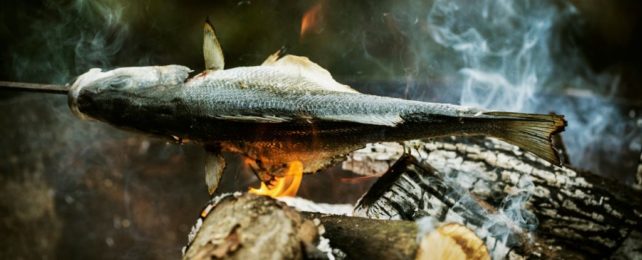What sets humans apart from other animals? It's a burning question that some scientists say boils down to the fine control of one earthly force: fire.
The British primatologist Richard W. Wrangham is a big proponent of the so-called 'cooking hypothesis'. Today, there is no known human population that lives without cooking, which suggests it is a powerful and necessary skill.
Wrangham argues that the evolutionary shift from raw to cooked food was the "transformative moment" that fueled the bellies of early humans and allowed their brains to grow, giving rise to our genus and ultimately our species.
A new discovery in Israel makes that idea even more digestible.
An international team of scientists working in the northern sector of the Dead Sea claims to have found the earliest signs of cooking by prehistoric humans.
At an archaeological site called Gesher Benot Ya'aqov, the remains of ancient carp-like fish show signs of having been carefully heated 780,000 years ago.
The discovery is not the oldest evidence of the controlled use of fire by early humans, but it is the oldest evidence in Eurasia. In Africa, Homo erectus sites dating back at least 1.5 million years contain charcoal and burnt bones.
Yet these are only circumstantial signs of burning, not clear signs of cooking. Evidence of the latter is much harder to come by.
In fact, signs of cooking don't really show up in the archaeological record until long after the arrival of Neanderthals and Homo sapiens. Until recently, the oldest evidence of cooking was the heated remains of starchy plants found in an underground oven in Africa. And that site only dates back 170,000 years.
That's 600,000 years after early humans in Israel were cooking fish in a valley near the Dead Sea.
"We do not know exactly how the fish were cooked but given the lack of evidence of exposure to high temperatures, it is clear that they were not cooked directly in fire, and were not thrown into a fire as waste or as material for burning," says archaeologist Jens Najorka of the Natural History Museum in London.
The team's recent analysis suggests the teeth of ancient freshwater fish found at the site were caught at a nearby lake, no longer in existence, and exposed to suitable temperatures for cooking.
The findings push back our ancestors' control of fire to the mid-Pleistocene, a time when populations of Homo erectus were giving way to bigger-brained hominins, like Homo heidelbergensis.
"Gaining the skill required to cook food marks a significant evolutionary advance, as it provided an additional means for making optimal use of available food resources," explains archaeologist Naama Goren-Inbar from the Hebrew University of Jerusalem.
"It is even possible that cooking was not limited to fish, but also included various types of animals and plants."
Gesher Benot Ya'aqob is a site rich in the remains of ancient hominins. Archaeologists have found evidence of flint, basalt, and limestone tools here, as well as fruits, nuts, seeds, and many species of land mammals, both medium and large.
Whoever lived in this valley clearly knew the land well. But it was their understanding of freshwater habitats that researchers think allowed this population to really thrive.
It might have even helped humans leave the African continent and live elsewhere. By jumping from freshwater habitat to freshwater habitat, hominins could ensure they had a good supply of fresh water and nutrient-rich foods.
Scientists have argued for years now that eating fish rich in omega fatty acids, zinc, and other crucial nutrients is what allowed the human brain to evolve such great complexity.
Raw fish probably suited the earliest hominins just fine, but as cooked fish made its way into our ancestors' diet, it would have made digestion easier and saved people from consuming dangerous pathogens. It would have also given hominin brains a bigger boost of nutrients.
The fish fried in Israel may have just been the start of our humanity's culinary prowess.
"This study provides evidence of fish cooking by early hominid … emphasizing the role of wetland habitats in offering a stable, year-round source of food that played an important role in hominin subsistence and dispersal across the Old World," the authors conclude.
The study was published in Nature Ecology and Evolution.
